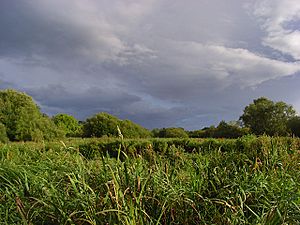Kennet and Lambourn Floodplain facts for kids
| Site of Special Scientific Interest | |

Rack Marsh
|
|
| Area of Search | Berkshire Wiltshire |
|---|---|
| Interest | Biological |
| Area | 23.4 hectares (58 acres) |
| Notification | 1996 |
| Location map | Magic Map |
The Kennet and Lambourn Floodplain is a special natural area in England. It covers about 23.4 hectares (which is like 58 football fields!) and is known for its important wildlife. This area is called a Site of Special Scientific Interest (SSSI) because it has unique plants and animals.
It's located in six different spots along the River Lambourn in Berkshire and the River Kennet in Wiltshire. These rivers flow through low-lying land called floodplains. The Kennet and Lambourn Floodplain is also part of a larger protected area called a Special Area of Conservation. One part of this area, called Rack Marsh, is looked after by the Berkshire, Buckinghamshire and Oxfordshire Wildlife Trust.
What Makes This Floodplain Special?
The Kennet and Lambourn Floodplain is very important for nature. It has special wet areas called fen or swamp habitats. These habitats are home to some rare and important creatures.
Amazing Animals of the Floodplain
One of the most important animals found here is the Desmoulin's whorl snail. This tiny snail is very rare and its numbers are decreasing across the country. Because it's so special, it's listed in the British Red Data Book, which keeps track of species that need protection.
Another part of the floodplain, called Eddington Marsh, has beautiful grasslands that are full of different plant species. These grasslands are also home to several rare insects. Some of these include special types of flies like Pherbellia griseola, Psacadina verbekei, Platypalpus niger, and Oxycera morrisi. Finding these rare insects shows how healthy and important this natural area is.
Where is the Kennet and Lambourn Floodplain?
This special area is made up of six separate locations. These spots are spread out across the floodplains of the River Lambourn in Berkshire and the River Kennet in Wiltshire. Each location helps protect the unique fen, swamp, and grassland habitats that are vital for the rare snails and insects living there.

